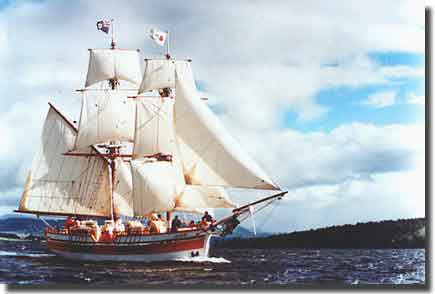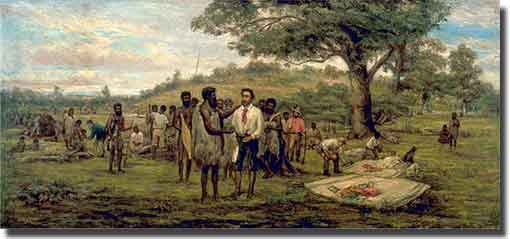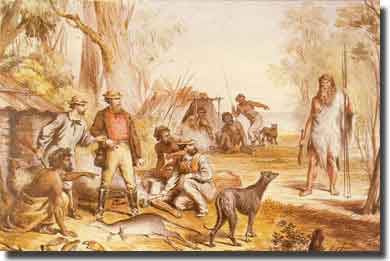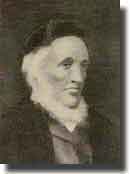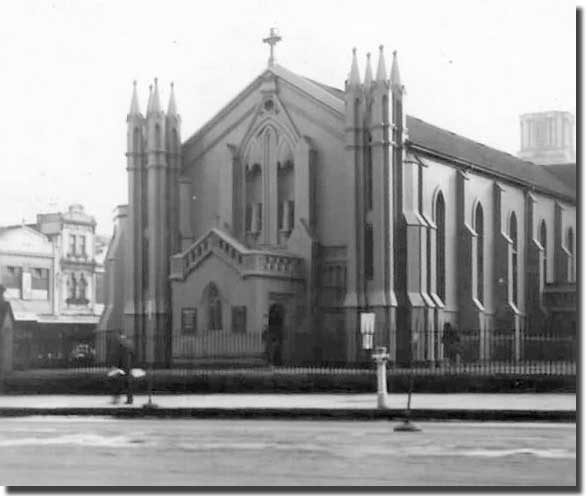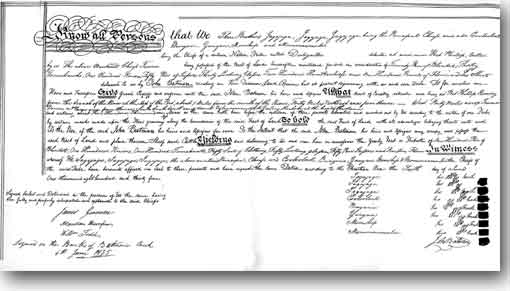|
The Discovery of Port Phillip Bay, Victoria, Australia, and its early settlement 1802 - 1835
Introduction. Grant sets out, then sails the southern coast of Victoria.
By the 3rd. of December he raised a promontory which he called Cape Northumberland, and the two mountains behind it Gambier and Schank, he altered course to the south, passed two islands at the entrance of a bight which he now named Portland Bay after his First Lord. Grant coasted eastwards, passed the already named Cape Otway, until reaching Wilson’s Promontory where he was unsuccessful in trying to go ashore there. He passed through Bass Strait and pressed on up the east coast to Sydney where he arrived on the 16th. of December. Lady Nelson was the first ship to go “sounding on, a dim and perilous way” through the Strait named after the explorer Bass, and now used by all ships proceeding along the south of Australia to Sydney or other ports of the Pacific Ocean. Grant’s second exploration. Murray sails south. Grant was thwarted by the prevailing winds, and was unable to enter what seemed to be an inlet leading perhaps to an estuary, but was really the narrow entrance to Port Phillip Bay. He sent off Bower, his first mate, with five sailors in a launch to examine this inlet, Bower rounded the promontory which Grant had named Point Nepean, and his launch was swept by the rushing tide of the rip through the narrow entrance into the wide expanse of this new waterway on the 1st. day of February 1802. Bower and his crew now viewed a great inland sea opening up before them, they stayed until the 4th. when they returned to Lady Nelson to report the exciting news. Now, on the 15th. of February, the brig sailed through the heads into this new found expanse of water. I do not know who first penned the following four lines:
Lieutenant Murray was pleased with the landscape scenery of the “noble harbour” that unfolded before his eyes, and compared it with that of Greenwich Park and Blackheath. When he went ashore he found native huts, and several hundred acres which had been cleared by fire. An island sitting in the West channel he called Swan Island, and on the eastern shore a lofty rise was named Arthur’s Seat, as it reminded him of the massive hill behind Edinburgh.
Grant spent three weeks exploring the land adjacent to where his ship was anchored, and on the 9th. of March took formal possession of the country in the name of the King, hoisted a flag on Point Patterson, and discharged three volleys of small arms, and artillery. On the 12th. he sailed his ship through the rip, on an ebb tide, and returned to Port Jackson by the 24th of March 1802. Lady Nelson faded from history, the last heard of her was in January 1825, she was reported trading in Torres Straits, where she fell into the hands of the Malays, her crew massacred, and the ship seemingly destroyed, she was not heard of again. Flinders enters Port Phillip Bay. On returning to Sydney his favourable report to Governor King found him urging the Duke of Portland to authorise the formation of a settlement at Port Phillip, as it appeared to have both good soil and a suitable climate, and also to stop the French from colonising this area. Before King could get a decision from the authorities in England, he told his Surveyor General Grimes, and Lieutenant Charles Robbins to survey the area around the harbour. Grimes now discovered the Yarra River, but his report on the suitability of the area for settlement was strangely negative. Meantime, the British Government had decided to go ahead with setting up a settlement at Port Phillip, and ordered Lieutenant Governor Collins to proceed to Port Phillip and establish a settlement there. His choice was unfortunate, he seems to have come to Australia with a preconceived idea that his mission was bound to fail. Collins sailed on the 24th. of April 1803, in Calcutta, with the storeship Ocean in company, on board were 299 male convicts, 16 married women, a few settlers, and 50 men and Petty Officers of the Royal Marines. Calcutta made the journey to enter Port Phillip Bay on the 18th. of October, only to find that Ocean had already arrived. A landing was made just inside the heads at what is now Sorrento, and Lieutenant Tuckey and two assistants were sent off in Calcutta’s launch to survey the harbour, this task occupied the next 9 days. Collins did not like what he saw, “The disadvantage of Port Phillip, and the unsuitability of the bay itself, when viewed in a commercial light, for the purposes of a colonial settlement” were strongly dwelt upon by Collins in his report to the Admiralty, he predicted that the harbour would never “ never be resorted to by speculative men.” Lord Hobart now ordered Collins to break up the settlement and proceed to the River Derwent, in Van Dieman’s Land, Collins happily pulled up stumps and quit, leaving the area on the 27th. of January, 1804. Although the settlement had only been in existence over 15 weeks, there had been 21 deaths, one birth, the first white child to be born in Victoria on the 25th. of November 1803, was named William James Hobart Thorne, but the wedding did not take place until the 28th. of that month between a convince Richard Garratt and Hannah Harvey a free woman, the first deal was that of a settler, John Skilhorne on the 10th. of October. Victoria unexplored for the next 20 years. Another attempt to Colonise in the Port Phillip area is made. He in turn asked that a formal colony now be set up there, and Sir Ralph Darling as the new Governor at Port Jackson sent off 20 soldiers and 20 convicts to colonise the area on the 9th. of November 1826, although he was confused by previous reports of poor land, etc. from Collins. HMS Fly sailed into Western Port on the 2nd. of December, and a settlement was started on the eastern shore near Corinella. Hovell, who had been sent along with this group to continue exploration of the area had to admit this was not the same area he had previously explored with Hume. The site soon proved very unsuitable, little fresh water was found, the shore line mudflats and mangroves made life difficult for the new settlers. The colony did not last long, by July the next year 1827 the colony was no more. Even today, Corinella has a very limited population and is an essentially farming area, my wife Denise, has a brother there, Kevin O'Brien with his wife Tanith have a large land holding, Lauriston, where they breed and train race horses, run cattle, have a vineyard, and olive groves. A beautiful new home faces the waters of Western Port with French Island in the distance, as one looks out to sea it is virtually the scene that Bass might seen in 1798. Civilian interests move into Victoria. Around Portland Bay had been used annually by whalers and sealers during the season each year from April to October. William Dutton in 1828 appears to be the first to have landed here when he in December of that year he went sealing later than normal, the next July he was back again, put up a hut, stayed a few months and planted potatoes to help feed his party. He claimed to have lived in this area at different times from March 1831 to March of 1833, and always wanted to be known as the founder of the first settlement in Victoria. But our history gives that honour to Edward Henty, one of seven sons of Thomas Henty, a farmer from Sussex England, who had become unhappy with his prospects in both New South Wales and Van Dieman’s Land. Edward had got wind of the good land on the south coast of the mainland, and in July 1833 had visited Dutton at Portland Bay, returning to urge his father to take a look at the Portland area, and then make moves to secure land there. Another brother James, approached the Secretary of State for the Colonies seeking to purchase land in the Portland Bay district, Lieutenant Governor Arthur, of Van Dieman’s Land, gave his support to this request, he could see this was a way to extend his authority across Bass Strait into the mainland in Victoria. Edward Henty decided he would not wait for a formal approval from the Home Government in England, off he went, to land at Portland on the 19th. of November 1834, and by the middle of 1836, this new colony was well and truly up and away, much involved in whaling. James Henty went off to London to try and legally purchase the land where the family had squatted, he was unsuccessful, but this first settlement in Victoria continued to thrive, although it was founded illegally. By 1836, Crown land grants had ceased in the now called Tasmania, and the Port Phillip District became a viable option.
A number of people moved across the water from Tasmania to Portland and into the Western District, and now a Tasmanian farmer John Batman, sailed the Rebecca across the strait into Port Phillip Bay on the 29th. of May 1835. In the northern Tasmanian town of Launceston, Batman had earlier formed the Port Phillip Association, and had wanted to settle there for some seven years. With his crew they explored the bay, liked the look of the land, made friends with the local aborigines, he now did a deal with the Dutigalla Aboriginals, for 30 small tomahawk axes, 100 knives, 40 blankets, 200 handkerchiefs, some flour, scissors, small mirrors, a few shirts and beads, he obtained 240, 000 hectares of land ( all the way from Point Lonsdale to Black Rock. )
He marked out a spot on the Yarra River for a settlement ( this is the place for a village, so our folk history records ) he settled three servants and five Aboriginals from Sydney at Indented Head to mark his purchaser, and returned to Launceston to report back to the Port Phillip Association, and get ready for consolidating this new settlement on the Australian mainland. These Batman servants were very suprised a few weeks later when a tall white man dressed in kangaroo skins arrived, it was William Buckley, a convict who had made good his escape from the ill fated Collins settlement at Sorrento back in 1804. He had lived with the local aborigines for 30 years, and had come to warn the small party of a planned attack on them by the Aboriginals, for this act, he was pardoned by Governor Arthur, he returned to Tasmania in 1837.
Batman, back in Launceston and trumpeting how he had become “the largest land holder in the world” sparked the interest of another farmer, John Pascoe Fawkner. He organised an expedition, and under Captain John Lancey they sailed in the Enterprise through the heads of Port Phillip Bay on the 16th. of August 1835. They soon found the Yarra River having no idea that Batman had already been here, they landed, built a sod house to hold stock, but were soon visited by John Wedge who had arrived to survey Batman’s acquisition, he warned the new party they were on private property. Lancey stayed on, and Wedge soon moved the Indented Head settlement to a site by the Yarra.
Fawkner made an agreement with Batman, and moved his settlement to the south bank of the Yarra River, in November 1835, Batman returned with 500 sheep and 50 cattle, and by April of 1836 had finally established the township near today’s Queen’s Bridge. History of St Francis Church, Melbourne.
Picture of St.Francis Church Melbourne 4th. October 1841
St Francis Church Melbourne December 1956.
Conclusion.
Back to index of early Australian explorers |

